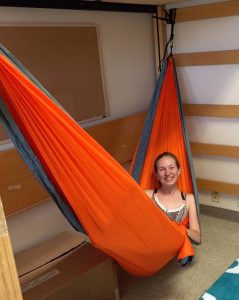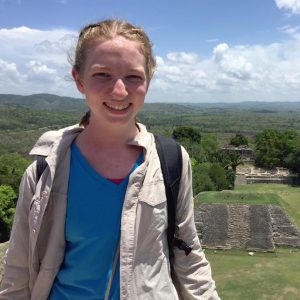Meet Anna Lunderberg. Don’t let the relaxed pose in the hammock fool you. This summer, Anna is  hard at work on campus, doing things like studying the brain tissue of rats and running Western blots. (Yeah, I had to Google that, too.)
hard at work on campus, doing things like studying the brain tissue of rats and running Western blots. (Yeah, I had to Google that, too.)
Anna, a soon-to-be sophomore at Hope, is collaborating with biology and chemistry professor Dr. Leah Chase on neuroscience research through the summer. For Anna, who is still uncertain about her major, this is a great opportunity to explore possibilities.
Anna came to Hope last year thinking she would be a physics major. During the summer of 2016, before her freshman year had even started(!), she participated in lab-based research at Hope with physics professor Dr. Jennifer Hampton. During the fall semester, Anna continued her physics research and participated in Hope’s Phage Discovery program. Students in this program do microbiological and molecular research to isolate, identify and investigate phages (viruses that infect bacteria.) They then share their discoveries in public databases used by researchers worldwide.
So, by the end of her first year, the Phage program had made Anna a bona fide researcher. What’s more, the program drew her into the biochemistry lab, where she discovered interests beyond physics.
Today in the lab, Anna is conducting research that will benefit mental health treatment. She studies rats that have been exposed to a derivative of homocysteine, a chemical found in higher concentration in the blood of individuals with neuropsychiatric disorders. She then determines if these rats respond better to lithium, a common treatment for bipolar disorder, or ketamine, a common treatment for depression. Using Western blots, Anna also studies how the proteins in the rats’ brains changed. The goal is to better understand the neurochemical changes associated with neuropsychiatric disorders.
“Even though things don’t always work the first time, it’s such an amazing feeling when things go right or everything falls together,” says Anna. “Procedures don’t always go well, but this is a universal part of science, and there is such a supportive environment here since everyone is going through the same thing.”
same thing.”
On any given day, Anna’s work is varied and well-supported, thanks to the active summer research community at Hope. She may be running tests in the lab, examining published research in her area, presenting her own findings to faculty and students or participating in weekly seminars. And, with programs like Chemistry Club’s Tuesday night beach picnics, she’s having fun with others her share her interests.
At Hope, you’ll hear a lot about collaborative student-faculty research. You’ll also hear about opportunities to participate in graduate-school-style research. Anna Lunderberg is making the most of both of these, and in the process making Hope a better and more interesting place.

